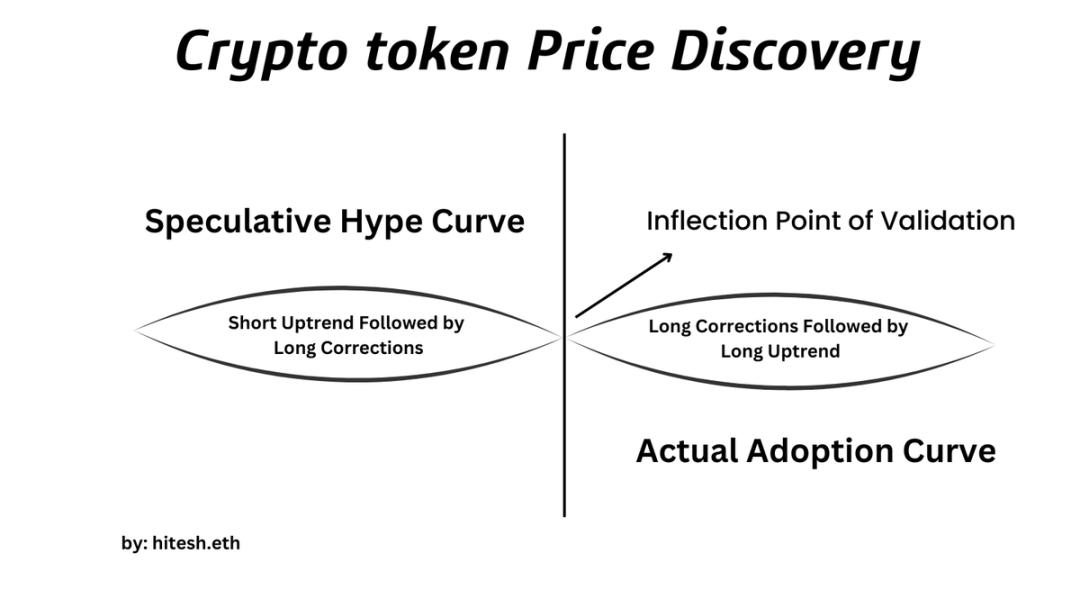Original author: hitesh.eth
Original translation: Saoirse, Foresight News
At their core, crypto tokens are about belief. They are the purest financial instruments ever created, designed to extract hope from humanity and convert it into liquidity. Token price fluctuations stem not from practical value but from narratives, from manipulation, from those who understand how to turn "attention" into a weapon to manipulate the market. This isn't a normal market, but a psychological battlefield. Most people are completely unaware that they are prey in this battlefield.
Price Discovery
No matter how hype-filled the hype, all crypto tokens follow the same price discovery cycle. It begins in the "0-1 phase": hype reigns supreme, while actual adoption is near zero. Prices soar on sentiment alone, communities form around a fictitious "future vision," and the hype overshadows reality. Then, a brutal correction inevitably follows—one that weeds out shaky holders and exposes those who blindly jumped in on promises.
Periods of deep decline often mark crucial turning points. Projects without real demand quietly wither away: they stop posting tweets, cease technical development, and slowly disappear from the market, while liquidity shifts to other projects. However, a few tokens survive and enter the "1-10 phase"—when hype dies down and real-world adoption begins. These tokens experience a period of slow, unremarkable growth until real demand reignites a second wave of "belief." It is this second wave of belief that fuels a long, powerful rally. Only these tokens survive cycle after cycle; most never make it.

Hidden truth
Going forward, tokens will be meaningless for most projects. Once private companies can directly tokenize equity and raise liquidity on-chain, the vast majority of crypto tokens will become worthless. Currently, only two sectors have tokens with real value: decentralized physical infrastructure networks (DePINs) and parts of decentralized finance (DeFi)—because they drive supply-side participation and collaboration. All other token-related activities are essentially financing schemes disguised as "innovation."
Most tokens exist essentially because founders want to quickly cash in—but that era is coming to an end. Better fundraising methods are emerging, and regulatory policies are on the way. However, meme coins and junk tokens won't disappear; they'll only increase in number—because gambling is human nature. The only change will be that the line between "gambling" and "investing" will become clearer: when you're gambling, you can no longer use "long-term investment" as a cover. You have to make a choice: admit you're gambling or invest. Right now, everyone pretends to be an investor, even those chasing memes and hype.
Psychological trap
Crypto tokens are essentially "strings of promises," designed to manipulate human behavior. Token supply unlocking mechanisms are designed to manipulate people's "hope," and lockup schedules are established to slowly instill "belief" into the market. The so-called "incentives" aren't just financial inducements; they're carefully crafted emotional traps. The true "product" of these projects isn't the token, but "belief." Every propaganda narrative targets the "reactive mind"—the part of you driven by emotions like fear, insecurity, guilt, and desire.
People aren't buying tokens; they're buying "an escape from the present." This is why tokens spread faster than logic—because belief spreads faster than truth. This is also why "coordinated hype" exists: venture capitalists enter the market early, market makers manipulate prices, exchanges time token listings, influencers incite greed, whales quietly build positions, and finally, retail investors enter the market at the end of the chain, becoming the "buyers" (providing exit liquidity). This isn't a conspiracy; it's the inherent process of market operation, the norm for the entire system.
The demise of tokens
Speculation, not practical value, drives token growth. All tokens are engaged in the same "battle for attention"—those that fail to retain that attention will ultimately perish. In this market, attention trumps practical application, revenue, and product usage. Most project teams fail to grasp this, focusing solely on price fluctuations while neglecting user growth.
Some projects use incentives to create the illusion of growth, but once users begin to care more about token price than the product itself, the game is over. Incentives, supposed to be a bridge to real-world adoption, are instead being used as a substitute for real demand. When a project loses control of its token's dynamics and becomes a prisoner of its own price chart, its core mission collapses: founders stop focusing on development and instead resort to perfunctory measures; the project's vision dies, and the token becomes a curse. For projects that could have succeeded without a token, the token ultimately becomes their grave.
Exit Liquidity
If you don't know who you're buying tokens from, you're essentially someone else's "exit liquidity." The token price discovery process is essentially a coordinated game manipulated by insiders: venture capital firms, exchanges, market makers, investment alliances, whales, and key influencers, all working together to control the market. When retail investors see a token's popularity soar, insiders have already established positions, waiting for retail investors to enter the market and provide liquidity. The seed round is the stage where the greatest wealth is created, but retail investors never have the opportunity to participate—projects raise funds at extremely low valuations, only to achieve fully diluted valuations in the billions upon IPO.
Retail investors often think they're "entering the market early," but in reality, they're already late. Their entry simply provides an exit opportunity for those who entered at a lower price. To survive in this game, you must anticipate narrative trends, enter before influencers start promoting them, and establish positions before liquidity incentives kick in. If you wait until YouTubers start recommending a token, you've already lost. If you don't do your own research, it's not "investing"—you're simply "borrowing someone else's beliefs," and such borrowed beliefs will ultimately lead to huge losses.
Future differentiation
The crypto world is splitting into two worlds: "regulated crypto" and "crypto anarchy." The former is government-controlled, with compliant infrastructure, approved tokens, and pervasive surveillance; the latter is raw, brutal, and free—a world where privacy-driven blockchains, true decentralization, and hard-working developers will thrive. Tokens were originally symbols of the "counterculture," but that culture has long since vanished. Cryptocurrencies have betrayed their original purpose, becoming "Wall Street on the blockchain." However, a "purging" is imminent: tokens without real demand will perish, and projects without a core purpose will disappear.
Narratives without substance will wither. Only tokens tied to "real applications, real cash flows, and real goals" will survive; all others will vanish. You need to understand why you're here—because tokens are like a mirror, revealing your greed, your impatience, and your fantasies. Most people come here for "freedom," only to be trapped in speculation; for "wealth," only to lose themselves in greed; for "truth," only to be addicted to lies. This market can't save you, and narratives can't save you—what can save you is discipline and insight. The rules of survival are simple: learn the rules, act before the crowd, never be a scapegoat, recognize who you are, and then commit to this "battle."
Conclusion
The crypto market doesn't reward followers, it rewards those who see through the illusion. The crowd is always slow to act, always chasing the hype, and always being the one to take over. Don't be part of the crowd: build your own processes, cultivate your own strengths, and cultivate your own patience. If you understand the game, you won't fear it—you'll exploit it.
This "cleansing" won't destroy you; it will only create opportunities. The road ahead won't be easy: the market will test your convictions, your timing, your patience, your emotional control, and your ability to hold onto the truth when the crowd is drowned out by the noise. Now isn't the time to pray for a bull market, but to build your own convictions. Only one question remains: when the next cycle begins, will you be an "early adopter" or, once again, a "buyer"?
- 核心观点:加密代币本质是信仰驱动的心理博弈。
- 关键要素:
- 价格波动源于叙事而非实用价值。
- 代币设计旨在操控人类情感与行为。
- 散户常成为内部玩家的退出流动性。
- 市场影响:加速劣质代币淘汰与市场分化。
- 时效性标注:长期影响



